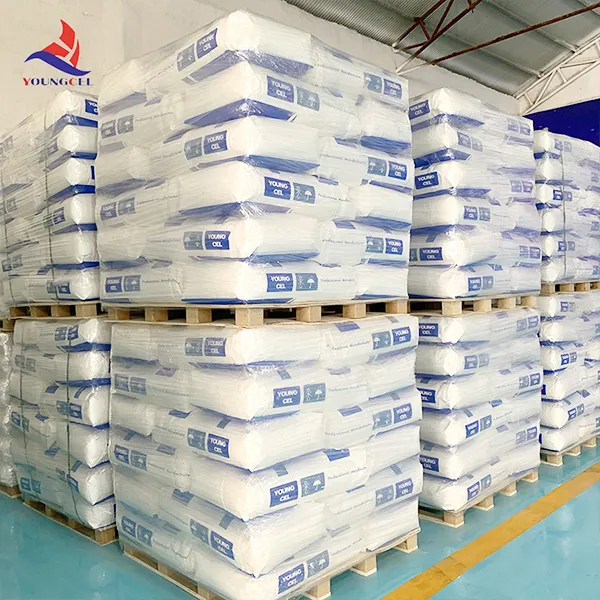Hydroxyethyl Methyl Cellulose for Liquid Soaps An In-Depth Look
The personal care industry is witnessing a significant shift towards more sophisticated and effective formulations, particularly in liquid soaps. One of the key ingredients that has gained traction is Hydroxyethyl Methyl Cellulose (HEMC). This versatile cellulose derivative is revolutionizing the way liquid soaps are produced and used, offering a range of benefits that enhance product performance and consumer satisfaction.
What is Hydroxyethyl Methyl Cellulose?
Hydroxyethyl Methyl Cellulose is a non-ionic, water-soluble cellulose ether derived from natural cellulose. HEMC is produced by the chemical modification of cellulose, introducing hydroxyethyl and methyl groups into the cellulose structure. This modification not only improves its solubility but also enhances its thickening, emulsifying, and film-forming properties.
In the context of liquid soap formulations, HEMC serves multiple functions, making it an invaluable addition. It is primarily known for its thickening properties, allowing manufacturers to create products with the desirable viscosity without compromising on the soap's feel or performance.
Benefits of Using HEMC in Liquid Soaps
1. Thickening Agent One of the most significant advantages of HEMC is its ability to act as a thickening agent. Liquid soaps require a certain viscosity for optimum application, and HEMC can effectively achieve this without the use of synthetic thickeners. This results in a smooth, pourable product that is easy to use while maintaining the desired thickness.
2. Stability Improvement HEMC contributes to the stability of liquid soap formulations. It helps to prevent phase separation and sedimentation, ensuring that the product remains consistent over its shelf life. This stability is crucial for consumer trust and satisfaction, as it assures users that the product will perform as expected throughout its use.
3. Enhanced Texture and Feel The inclusion of HEMC in liquid soap not only enhances its viscosity but also improves the overall sensory experience. Soaps that use HEMC feel richer and creamier when lathered, providing a more luxurious user experience. This sensory appeal is essential in a competitive market where consumers are often seeking products that deliver both functionality and pleasure.
hydroxyethyl methyl cellulose for liquid soaps

4. Emulsion Stabilizer Liquid soaps often contain oils and surfactants that can separate if not adequately stabilized. HEMC serves as an emulsion stabilizer, helping to maintain a uniform mixture of oils and water-based ingredients. This property is particularly vital for formulations that aim to combine moisturizing oils with cleansing agents.
5. Foaming Properties While HEMC itself does not generate foam, it can enhance the foaming properties of the surfactants used in the soap. This means that formulations containing HEMC can offer a satisfying lather while remaining gentle on the skin.
6. Eco-Friendly Option As consumers become more environmentally conscious, the demand for natural and biodegradable ingredients in personal care products continues to rise. HEMC, being derived from cellulose, is considered a more eco-friendly option compared to synthetic thickeners, aligning with the growing trend towards sustainability.
Formulating with HEMC
Integrating HEMC into liquid soap formulations is relatively straightforward. Typically, it is added during the heating phase of the manufacturing process, where it can fully hydrate and disperse in the aqueous phase. The recommended concentrations vary depending on the desired viscosity and specific formulation requirements, but it generally ranges from 0.5% to 3.0%.
Formulators should also consider the pH of the final product, as HEMC performs optimally within a specific pH range (typically between 5 and 9). Adjustments may be necessary to ensure compatibility and stability throughout the product's lifecycle.
Conclusion
Hydroxyethyl Methyl Cellulose is transforming liquid soap formulations by offering improved viscosity, stability, and consumer experience, all while aligning with eco-friendly practices. As the demand for high-performance, natural personal care products continues to grow, incorporating HEMC into liquid soaps presents an opportunity for manufacturers to meet consumer needs effectively. Its multifunctional properties make it a valuable asset in the formulation toolkit, ensuring that liquid soaps not only clean but also pamper the skin in an increasingly competitive market. With its myriad benefits, HEMC is poised to remain a key ingredient in the formulation of modern liquid soaps.
-
Rdp Powder: Key Considerations for Wholesalers in the Building Materials IndustryNewsJul.08,2025
-
Key Considerations for Wholesalers: Navigating the World of Hpmc - Based ProductsNewsJul.08,2025
-
Hpmc Detergent: Key Considerations for WholesalersNewsJul.08,2025
-
Key Considerations for Wholesalers: China Hpmc For Tile Adhesive, Coating Additives, Concrete Additives, and MoreNewsJul.08,2025
-
Crucial Considerations for Wholesalers: Navigating the World of Construction MaterialsNewsJul.08,2025
-
Key Considerations for Wholesalers Sourcing Additive For Cement, Additive For Concrete, Additive For Putty from Additive Manufacturer Shijiazhuang Gaocheng District Yongfeng Cellulose Co., Ltd.NewsJul.08,2025




